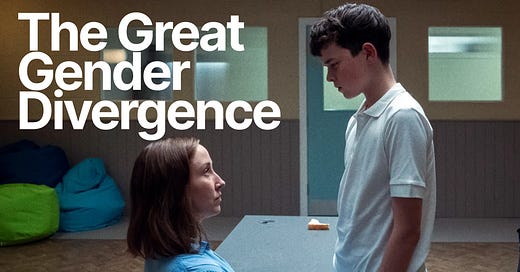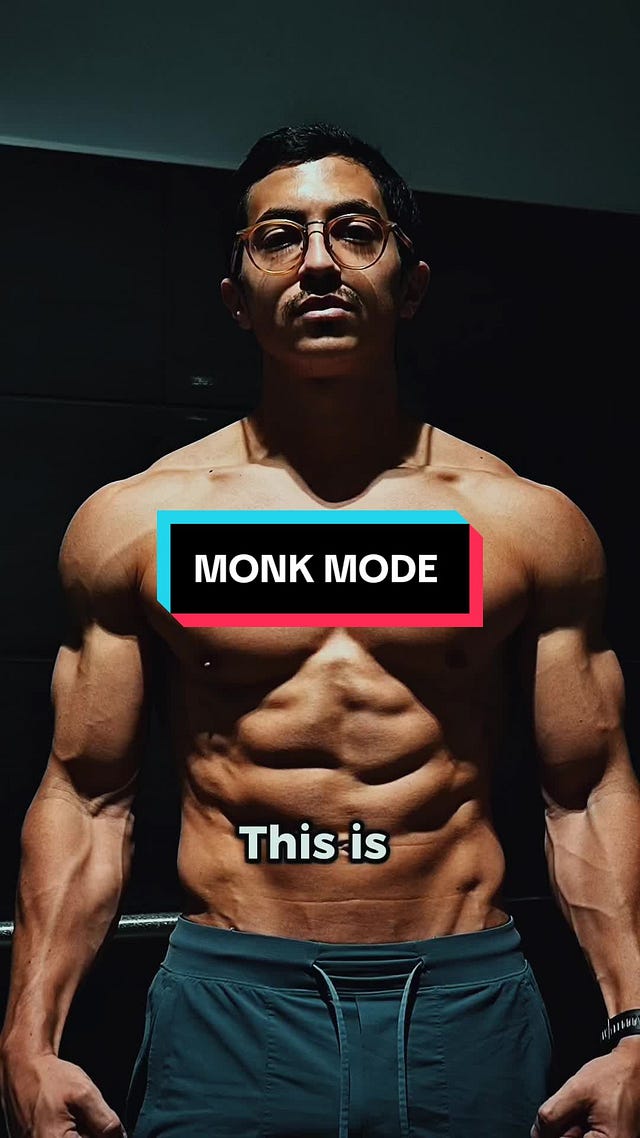Culture moves fast. One moment, a narrative dominates the conversation—then, almost instantly, a new reality emerges. I recently wrote about the apparent end of the Gen Z sex recession, but another shift is becoming impossible to ignore: young men and women aren’t coming together in this new era of intimacy—they’re pulling further apart.
Across social media, conversations about the ‘Great Gender Divergence’ are gaining traction, with commentators noting a stark divide: while young women and queer communities are embracing progressive ideals and more fluid gender identities, many young men are retreating into traditionalist, hyper-masculine ideologies. This isn’t just anecdotal. A Financial Times study confirms this growing chasm, and Gallup data shows that young women in the US are now 30% more liberal than their male peers, marking one of the most significant gendered political divides in Gen Z.
Recent polling suggests this divide isn’t just ideological but is actively reshaping social behaviours. In the wake of the U.S. election, debates over masculinity, feminism, and gender roles have only grown more polarised. Political commentators warn that the online radicalisation of young men is no longer confined to digital spaces; it's manifesting in real-world attitudes, particularly within conservative youth movements.
Source: The Guardian
And it’s not just in the States—it’s also playing out across the UK, where concerns about young men being drawn into misogynistic online spaces have prompted government intervention. In response to growing anxieties about figures like Andrew Tate shaping boys' attitudes, the UK government has issued guidance for teachers to identify early signs of involvement in “incel” culture among students over 14.
Source: Netflix
Netflix’s Adolescence serves as a stark reflection of these growing tensions. The show follows 13-year-old Jamie Miller, who is drawn into misogynistic, “red pill” communities online, ultimately leading to the murder of a female schoolmate. The show highlights how young men, particularly those feeling lost or disconnected, are so easily pulled into radical spaces. Adolescence makes it painfully clear that the ideological divide we see playing out in data and polling isn’t just theoretical but is actively shaping the lives and futures of Gen Z boys.
The gender divide is playing out in education and the workforce, too. Young women are outpacing men in higher education, with significantly higher university enrolment rates. For the first time, they’re also securing higher employment rates and even out-earning their male peers in certain fields. This shift marks a historic reversal of traditional gender dynamics, further widening the gap in how young men and women experience the world.
On the surface, this might seem like a win for women. But beneath the progress, a growing number of young men are becoming “disillusioned with society,” according to the study. Lacking clear role models for healthy masculinity, many are turning to figures who reinforce outdated gender hierarchies. Jordan Peterson, for example, continues to command a devoted following among young men, positioning himself as a guide for those who feel left behind in modern society. His emphasis on traditional gender roles and the perceived decline of masculinity only deepens this ideological divide. As a result, Gen Z is shaping up to be one of the most polarised generations when it comes to gender, with young men and women increasingly struggling to see eye to eye.
It’s not hard to see where this divide is coming from—social media algorithms are shaping entirely different digital worlds for young men and women. Platforms like YouTube, TikTok, and Instagram funnel users into gendered content silos, reinforcing distinct narratives about identity and success. Young women are immersed in content about beauty, relationships, self-improvement, and social justice, while young men are steered toward gaming, fitness, and so-called ‘self-improvement’ spaces—some of which act as a gateway to more extreme ideologies. This algorithm-driven divergence isn’t just reflecting existing differences; it’s actively widening the gap between how young men and women see themselves and each other.
 Tiktok failed to load.
Tiktok failed to load.Enable 3rd party cookies or use another browser
Over the winter months, the "Winter Arc" trend (now with over 42 million posts on TikTok) encouraged young men to dedicate October to January to self-improvement, focusing on intense gym sessions and personal discipline while cutting out romantic and sexual relationships, which were framed as distractions. But as Winter Arc faded many of the same influencers turned to ‘Monk Mode,’ an even more extreme version of self-discipline that extends beyond just a seasonal challenge into a year-round lifestyle. The core message remains: emotional vulnerability is weakness, women are a distraction, and true success comes through relentless self-optimisation and isolation. While this rhetoric isn’t new, its growing popularity highlights the deepening gender divide, as young men are increasingly encouraged to disengage from relationships in pursuit of hyper-individualised success.
Source: Daily Mail
Young women are increasingly deciding to ‘decenter men’ from their lives, following the likes of Emily Ratajkowski and Julia Fox. The #Boysober movement, which has amassed 7.3 million views, encourages women and girls to take a year-long break from dating and sex with men as a way to reclaim their autonomy and break free from the cycle of male validation.
So what does all this all mean? Brands and organisations are not just bystanders in this growing gender divide. As brands play an ever-expanding role in people’s lives, influencing identity and culture as much as they take from it, their responsibility goes beyond just selling products. They must move beyond surface-level messaging and actively contribute to shaping a culture that supports young men and women in healthier, more constructive ways.
There is a huge opportunity (and obligation) to engage young men with narratives that promote emotional intelligence, self-worth, and positive masculinity—rather than outdated ideals of dominance, detachment, or hyper-competition. This means not only designing products and services that foster personal growth and well-being but also taking a stand against the more insidious ideologies shaping young people’s worldviews.
Equally, brands must be intentional about who they amplify. Every partnership, campaign, and media buy either reinforces the divide or helps bridge it. Failing to take a stand against misogyny and hate isn’t a neutral act—it’s a risk. The backlash against platforms like Spotify for continuing to host Andrew Tate’s content, despite public outcry and petitions, shows that consumers are no longer willing to let brands sit on the fence. While cancel culture may be an overused term, the reality is clear: brands that remain complicit in elevating harmful voices will face reputational damage, consumer distrust, and financial consequences.
Those who choose to engage with thoughtfulness and cultural responsibility—rather than just capitalising on trends—will not only build deeper consumer trust but also help shape a future where gender identity isn’t dictated by algorithm-driven extremes.









I think it starts with showing our young men and women that they do not have to perform and be something they’re not. If there’s anything I took away from Adolescence it’s that we need to give young people better role models, beyond content creators.